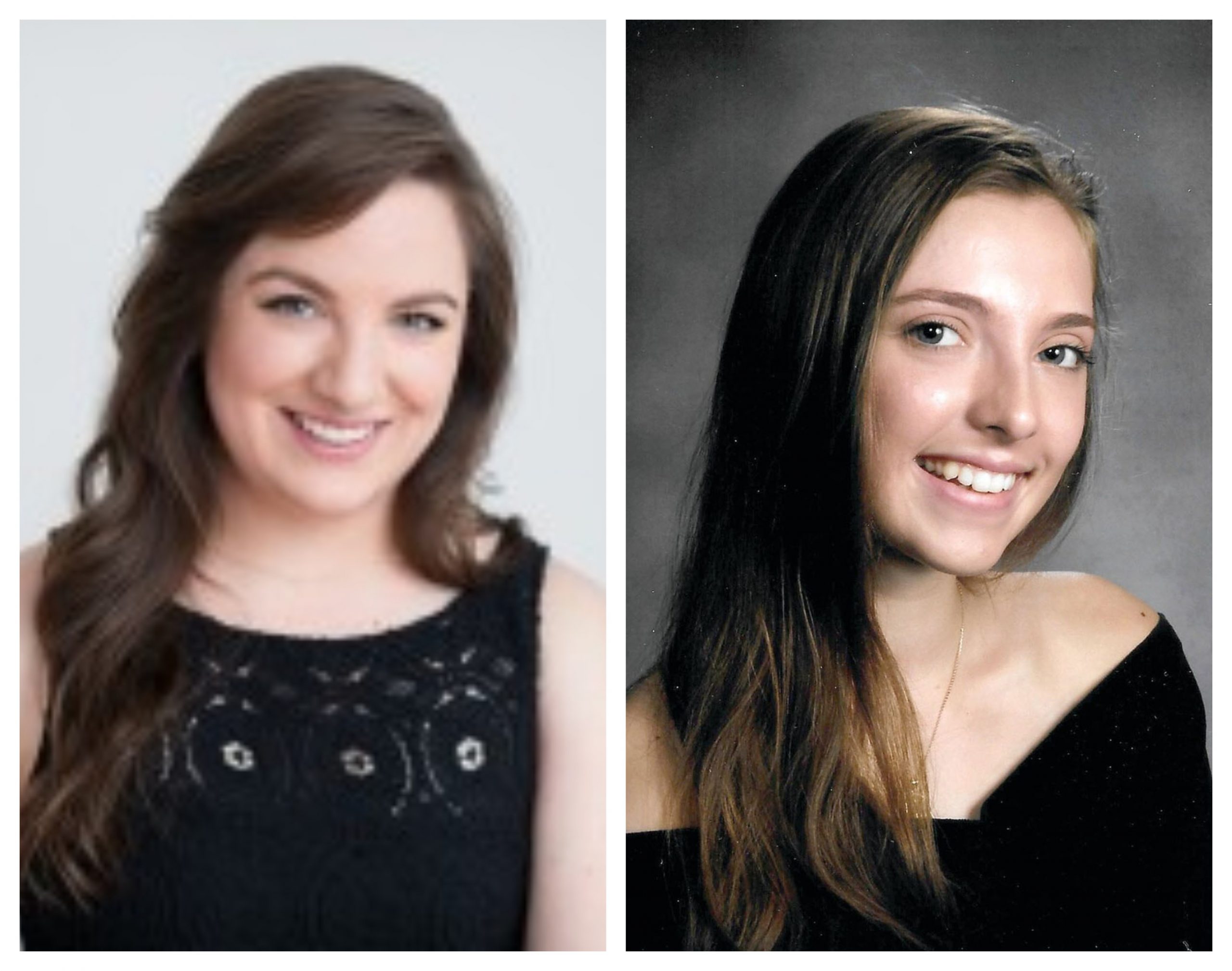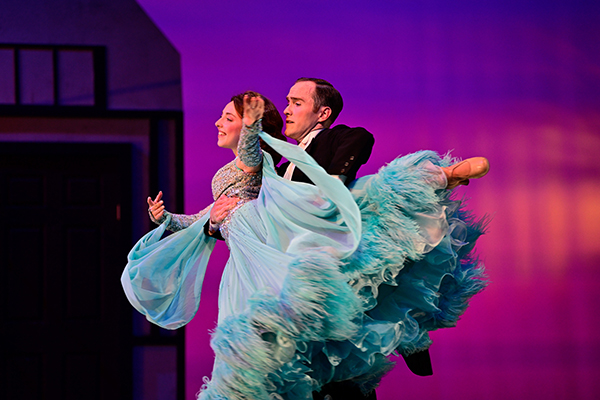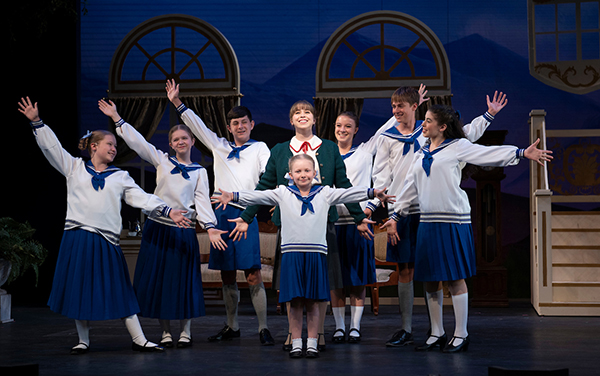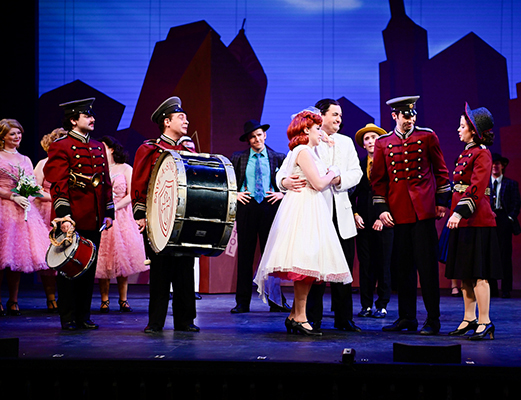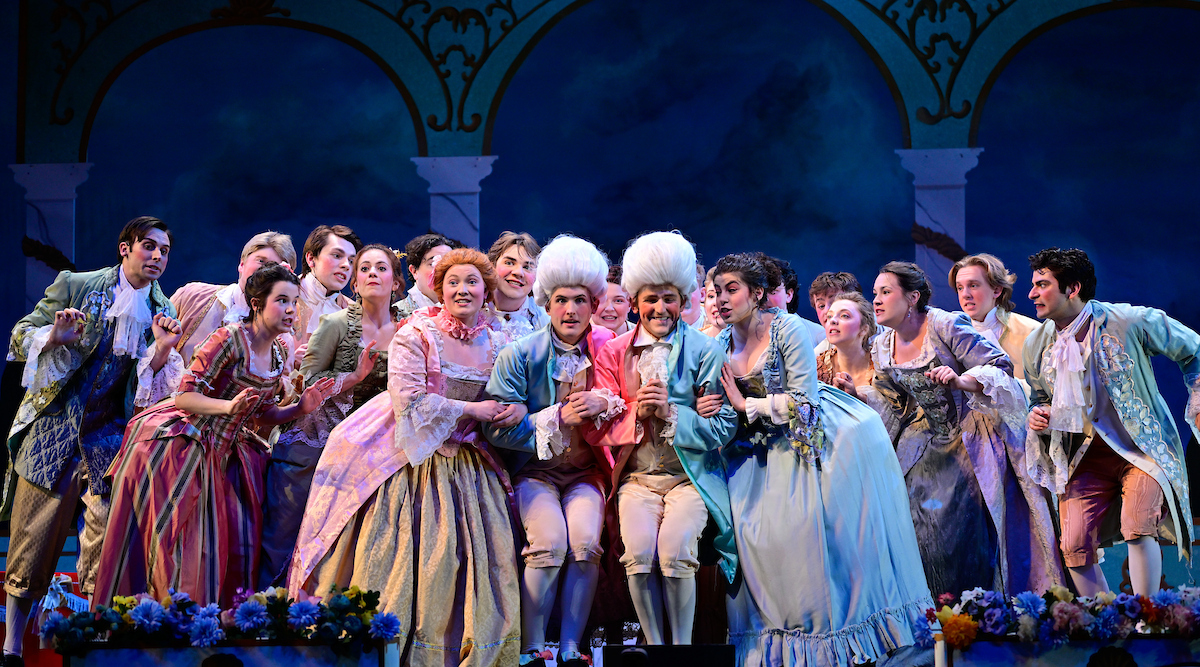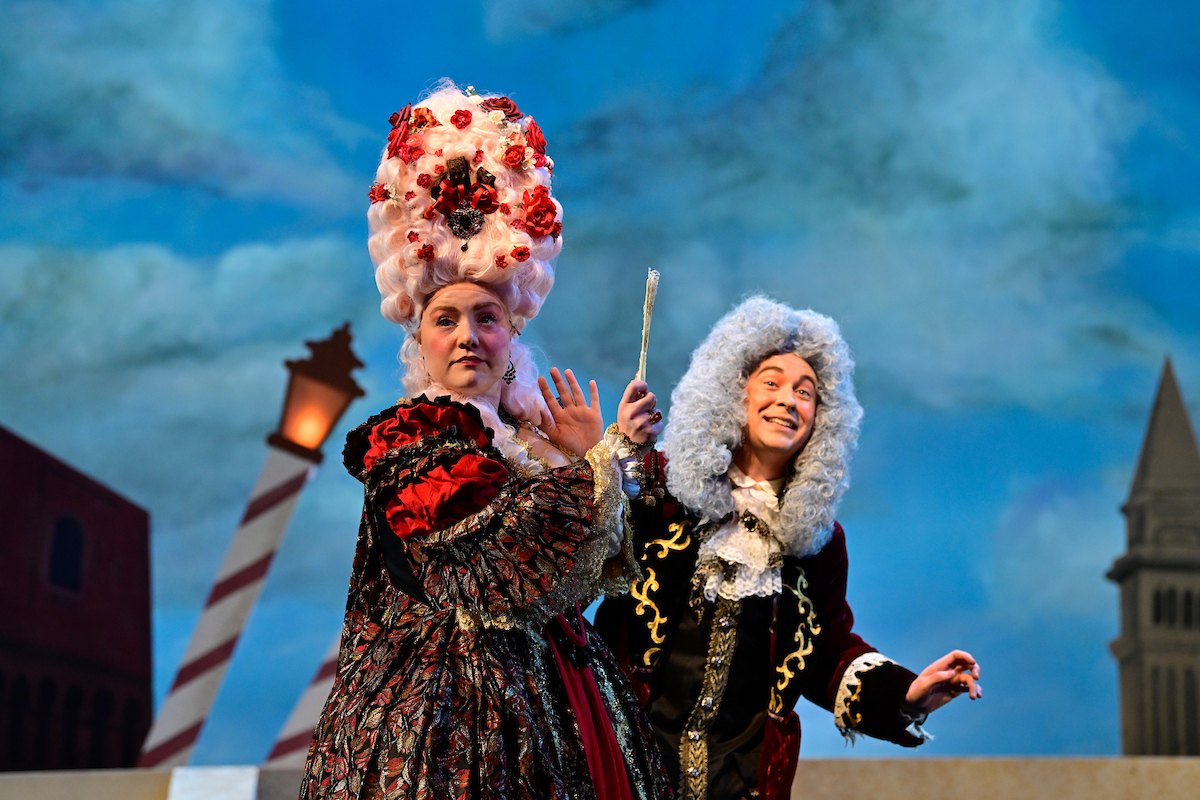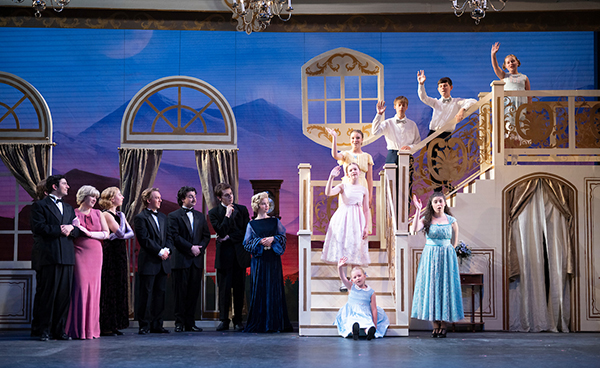by Mike Telin & Daniel Hathaway
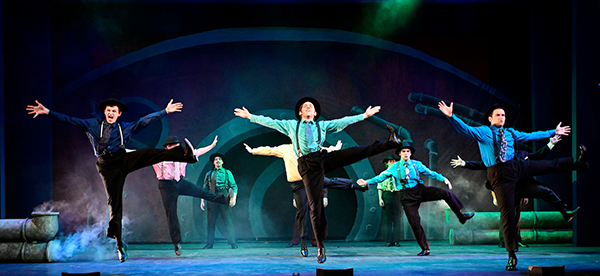
We asked OLO artistic director Steven Daigle to suggest a group of colleagues who would be willing to participate in an informal roundtable discussion about how all the moving parts come together for a summer of lyrical theater.
After seeing the second performance of Guys and Dolls on June 12, we returned to Freedlander Theatre later that evening to meet up with music director Michael Borowitz, choreographer, director & cast member Spencer Reese, returning cast member Maggie Langhorne, first-summer cast member Kate Bilenko, and assistant production manager & scenic designer Daniel Hobbs.
During the summer, Freedlander is a small city that never sleeps. As we were gathering in an alcove off the lobby in Freedlander, Trapp family children from the cast of The Sound of Music were running through the halls in costume, waiting for their dress rehearsal to begin.
Sitting down to begin, Spencer Reese mentioned that this summer he’ll celebrate his 60th OLO production.
Spencer, what do you look to for choreography inspiration?
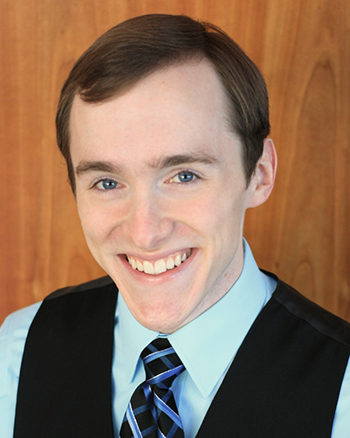
Sometimes I’ll watch research from the time period. What did social and recreational dancing look like at the time? I do try to start from a blank page. So I do spend a lot of time flailing around my apartment.
The audition process now includes technology to evaluate dancing skills. How has that helped to advance the company?
Reese: It’s been great to help elevate what we as a company are capable of putting into a production. It also gives us a more well-rounded view of each performer.
We’ve always seen what they have to offer vocally and dramatically, but until a couple of years ago we wouldn’t find out until they arrived in Wooster what they had to offer movement-wise. But now we can let folks know in advance what we are incorporating and what they will be participating in when they are here.
I send out an audition instruction video so I get to see them dance and they also get to see me teach. Which is a mutually beneficial way to manage expectations.
For the cast members: is dancing something that you are taught to do in school?
Maggie Langhorne (left): I came from the opera world, so there was less dancing involved. But you see more and more calls as productions are adding more physicalization into the storytelling.
I love dance. I think both Kate and I grew up with dance, so making a tape like that is not all that different from sending a tape for a pre-screening for a vocal audition. Spencer does leave a little bit of a window for us to improvise on our own, so it is special to see that he allows that creativity in us.
Kate Bilenko (right): I agree. My concentration is musical theater. We do have a lot of focus on dance, and from that you learn how to navigate a video. So we can research the shows that we are auditioning for and what possible moves there could be. And months later you think, “I did that in my video.” So it’s nice when you see the dots connecting along the way.
Reese: Kate is one of the best dancers we have ever hired.
Langhorne: I confirm — the first rehearsal of “Leaning on a Lamp Post” was so beautiful that I openly wept.
Reese (interjecting): Kate is shy about the compliments — I’ll brag on her behalf.
Daniel, what did you look to for inspiration for the show’s sets?

The gamblers, gangsters, and burlesque dancers are not the nicer side of New York City, but then again the show is comedic and they are larger-than-life characters. So we landed on this idea of kind of animated versions of NYC — Looney Tunes and things in the 1950s era.
So I tried to incorporate that into the designs, and I think we succeeded. We did a lot of forced perspective and visual tricks. The one I’m happiest with is the entrance into the sewer, when the floating crap game moves underground. The trap door drew “ooh”s from the audience this afternoon — people always love a trap door.
The moon was beautiful in both the Gotham and Caribbean scenes.
Hobbs: That was a collaboration with lighting. We all worked together — lighting, scenery, and costumes — to create something that feels cohesive. That transition from NYC to Havana was a big one. How can it feel like a new place and then go back again very quickly? I think we succeeded pretty well with that one.
It’s interesting to me because the design and production side can feel separated from everything else. We start conversations well before the summer, so we come in with designs done. But we can’t forget that dancing needs to occur, so they need to be functional — and hopefully the stairs are not going to kill anybody.
This is a fun place too, because by living and working in the same spaces we get to know each other really well. I actually met my wife here, who was a performer, so it’s not too separate between design, tech, and performance.
How do each of the cast members feed off of each other?
Bilenko: I’ve been joking that I feel like we’ve been here for three years already this summer, just based on how much time we all spend with each other. I’m very grateful for Maggie. I feel like I definitely made a friend, like when we’re sitting in the dressing room and having a conversation and going “Oh wow. How do you pace yourself when you know that you have a show in the afternoon and a dress rehearsal at night?”
So I’ve been taking the opportunity of talking to all the people who have been doing this professionally for years and asking them how they do it. Finding the downtime to spend with them and asking for their advice.
Langhorne: I think many of us are drawn to this year after year because of the love of the art. Not many places do this repertoire — and for myself and based on the conversations I’ve had with others, the golden age of musical theater and light opera has such a dear place in our hearts. We want to share that joy and artform with people. We are all working extremely hard, and the magic that we create fuels one another.

It’s the same with the dancing — watching their torsos and how they are moving, it inspires me to connect with them and make sure that they are feeling supported. There are moments in this show when something lighting-wise will happen that I haven’t really noticed before, and suddenly it all sort of makes sense.
It’s a little subconscious thing, but it’s so nice because I’m in the best seat in the house. I get to see it all up close and personal and I love that.
What is everyone looking forward to in the rest of the season?
Hobbs: I’m looking forward to The Gondoliers. It’s my second time designing a show that Spencer’s directing, and collaborating with him has been really great. He likes to find the joke in everything, and he incorporates that into what we on the design side don’t always do. That can be really fun for us.
Reese: I’m very excited about Gondoliers. As a director, I’ve tried to make sure that every department has things that they are excited about and that it doesn’t become a recreation of history or just going by what we’re all expecting.
Gilbert and Sullivan is the bread and butter of OLO, and if this is someone’s first G&S production I want them to see an honest G&S production — where it came from and what it would have felt like when it came out. But if this is someone’s 50th G&S show, I still want to surprise them. These shows were witty and zany in their time, so it’s a mixture of re-creation and creation all at once.
Hobbs: It’s interesting too because we designed this for the 2020 season, which didn’t happen because of COVID.
Reese: But for 2024 we started over. We didn’t look back at our notes — we started fresh.
I am excited for Me and My Girl. It’s a show that doesn’t come around all that often. It’s stylistically different from what we usually do. It really is a screwball comedy — very snappy and very fast. And Kate has been a dream to work with.
Bilenko: Ditto. I’m also very excited for Me and My Girl because we get to do everything all at once. We’re singing, dancing, and acting, pacing our breath and getting the laugh from the audience too.
I’m excited for all of the operettas — I grew up doing classical work, but when I entered undergrad I had to choose my concentration, so getting back here and doing the work that is closer to that type of repertoire is very rare. It has filled a piece of my heart that has been missing for a while.
Langhorne: My answer is also twofold. I’m very excited for Me and My Girl because I did the show about ten years ago at College Light Opera with the same character, and that producer is coming to see this one. And I’m excited because this show doesn’t get done all that often.
Guys and Dolls has been such a dream — Miss Adelaide has been a dream for me for ages. She’s silly and funny and brassy and big in character — all the things I love — and it’s really a joy to bring her to life.
Borowitz: Me and My Girl was a huge surprise for me. I didn’t know it at all, and when I looked at the score I had in my mind one way for it to be. I was completely wrong about that, because as soon as we did the sing-through and started to put it on its feet I realized that this is what entertainment is about. It doesn’t feel dated at all, it feels hilariously funny. There are also some serious moments, and Kate does a beautiful solo that really steals your heart.
Do you ever get confused about which show you’re doing?
Borowitz: I confess that I have gotten confused about which scene change music we are doing. But I am amazed what these folks keep in their brains, and they never seem to miss a beat.
Bilenko: This question encompasses the beauty of live theater. There was a guy who wore his Sound of Music pants for Guys and Dolls and he came backstage and said, “Thank god I have time to change the pants” — they do look the same, except one will rip when you dance in them and the other won’t.
As Spencer said, the directors are here to help us do our best — but if something goes wrong, we have to go home and say that tomorrow is a new day, because we do need to move on to the next show.
Reese: You’ve heard me talk about creating a world, and I think that is something that is so important to our rep. But as Michael was saying, it does take a little bit of upkeep to keep all the little nuances straight and entrances straight.
Hobbs: Just the sheer number of pieces that we have backstage — costumes and scenery — is why we’re thankful for the technical crew that we have. As a designer I can draw it and be done, but as part of the production management I helped hire the 50 people working on it. They are all great at helping and working with the performers during the show, making sure that everything is happening.
Langhorne: We show up at the hour of call, but their world is already there. The stage crew has been working their booties off. But their work is so beautiful that you feel immersed the moment you walk in.
Hobbs: All six shows are there at the same time and that has to be kept track of. And because there is a limited amount of storage space, if we can use the same platform for different shows we’ll do that as well. All the scenic designers make sure that the steps and platforms are the same height so that we can reuse those things.
I think we have to thank Sami Hansen, because she is that main person that keeps everything flowing.
Borowitz: I was so happy because this year we had almost 75% of the orchestra from last summer return. And that helps us keep building a kind of community. They love it and they enjoy the challenge. It’s never a dull moment for them in the pit. It’s nice, as Spencer said, allowing them to discover their own creativity within the perimeters that they have.
As symphonic players, they don’t necessarily have that kind of flexibility, so it’s fun to see just how much personality they can put in. It’s a good group and I am really very happy.
How does everyone like working in repertory?
Borowitz: Isn’t that why we love being here? I love doing one show in the afternoon and another at night. It’s so challenging and so creative.
Bilenko: A friend texted me and asked if the rehearsal schedule was stressful. I looked at it and thought, is it crazy? Yes, sometimes we’re running three shows in one day. But is it stressful? To me, it’s a job — you do the work before you come, so doing three shows in one day ends up being fun. You get to go along for the ride because hopefully you have your lines memorized and know where your feet need to be.
Langhorne: I think it makes you feel proud of yourself. There’s a certain, “Wow, I was able to keep all of that information in me mentally and physically and put it all onto the stage.” It’s a wonderful experience as a young actor. But people have been doing it for 45 years here.
Bilenko: As Michael said, you never do the same show twice.
Borowitz: I wish everybody had the opportunity to do something like this, because it really opens your eyes to a world of possibilities.
Reese: And you surprise yourself with what you are capable of. I’ve done this for so long I don’t get nervous anymore. Because when you do that many performances, you learn what it means to give that day’s best. And if you give 100% on that day, then you have done your best.
100% may be different from one day to the next. You’re going to give performances when you’re tired, sick, or your ankle is sore, but you learn how to take how you are on that day and give it all to what your character needs. For me, it’s really boosted my confidence to know that I can do it.
Everybody here is on each other’s side all of the time. I’ve never been involved in a production company that was this organized.
Hobbs: We all work with each other to make sure that it happens.
Langhorne: It’s all about extending grace and giving love to one another that makes it all happen.
Reese: That’s one of the reasons Steve Daigle has always insisted that we take only company bows, because we really are a team.
2024 production photos courtesy of Ohio Light Opera, which runs through July 28. Tickets to all six productions are available online.
Published on ClevelandClassical.com July 8, 2024.
Click here for a printable copy of this article




